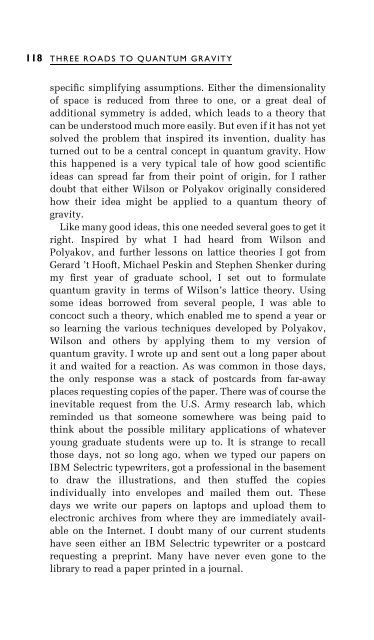Three Roads To Quantum Gravity
Three Roads To Quantum Gravity
Three Roads To Quantum Gravity
Create successful ePaper yourself
Turn your PDF publications into a flip-book with our unique Google optimized e-Paper software.
118 THREE ROADS TO QUANTUM GRAVITY<br />
speci®c simplifying assumptions. Either the dimensionality<br />
of space is reduced from three to one, or a great deal of<br />
additional symmetry is added, which leads to a theory that<br />
can be understood much more easily. But even if it has not yet<br />
solved the problem that inspired its invention, duality has<br />
turned out to be a central concept in quantum gravity. How<br />
this happened is a very typical tale of how good scienti®c<br />
ideas can spread far from their point of origin, for I rather<br />
doubt that either Wilson or Polyakov originally considered<br />
how their idea might be applied to a quantum theory of<br />
gravity.<br />
Like many good ideas, this one needed several goes to get it<br />
right. Inspired by what I had heard from Wilson and<br />
Polyakov, and further lessons on lattice theories I got from<br />
Gerard 't Hooft, Michael Peskin and Stephen Shenker during<br />
my ®rst year of graduate school, I set out to formulate<br />
quantum gravity in terms of Wilson's lattice theory. Using<br />
some ideas borrowed from several people, I was able to<br />
concoct such a theory, which enabled me to spend a year or<br />
so learning the various techniques developed by Polyakov,<br />
Wilson and others by applying them to my version of<br />
quantum gravity. I wrote up and sent out a long paper about<br />
it and waited for a reaction. As was common in those days,<br />
the only response was a stack of postcards from far-away<br />
places requesting copies of the paper. There was of course the<br />
inevitable request from the U.S. Army research lab, which<br />
reminded us that someone somewhere was being paid to<br />
think about the possible military applications of whatever<br />
young graduate students were up to. It is strange to recall<br />
those days, not so long ago, when we typed our papers on<br />
IBM Selectric typewriters, got a professional in the basement<br />
to draw the illustrations, and then stuffed the copies<br />
individually into envelopes and mailed them out. These<br />
days we write our papers on laptops and upload them to<br />
electronic archives from where they are immediately available<br />
on the Internet. I doubt many of our current students<br />
have seen either an IBM Selectric typewriter or a postcard<br />
requesting a preprint. Many have never even gone to the<br />
library to read a paper printed in a journal.



![arXiv:1001.0993v1 [hep-ph] 6 Jan 2010](https://img.yumpu.com/51282177/1/190x245/arxiv10010993v1-hep-ph-6-jan-2010.jpg?quality=85)


![arXiv:1008.3907v2 [astro-ph.CO] 1 Nov 2011](https://img.yumpu.com/48909562/1/190x245/arxiv10083907v2-astro-phco-1-nov-2011.jpg?quality=85)








![arXiv:1002.4928v1 [gr-qc] 26 Feb 2010](https://img.yumpu.com/41209516/1/190x245/arxiv10024928v1-gr-qc-26-feb-2010.jpg?quality=85)
![arXiv:1206.2653v1 [astro-ph.CO] 12 Jun 2012](https://img.yumpu.com/39510078/1/190x245/arxiv12062653v1-astro-phco-12-jun-2012.jpg?quality=85)
